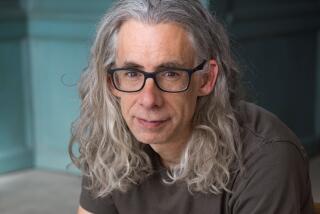Neal Stephenson takes the long view
SEATTLE -- For all of Neal Stephenson’s achievements, his most impressive may be his ability to attract a following equal parts hacker and literati. His popularity is all the more anomalous because his books are always long and often difficult. His last project, “The Baroque Cycle,” was a fictional trilogy about the birth of capitalism and the history of science, set partly in 17th century London, stretching almost 2,700 pages and written with a fountain pen.
His ambitious new novel, “Anathem,” imagines a world dominated by casinos, shopping malls and tire shops -- except for the walled monasteries where the devout gather to contemplate big issues in the shadow of a clock that runs for thousands of years.
They give up, needless to say, almost all contact with the secular world as well as most of its worldly pleasures.
“I had the idea that there would be people who voluntarily stay inside those walls,” said Stephenson, a fit 48-year-old who looks like he should carry a broadsword, “as a way of getting away from the distractions of everyday life, of doing something in a serious way that took a long time. And one of their jobs would be to care for the clock.”
Stephenson -- who with a shaved pate, mountain-man beard and pen tucked into shirt pocket seems part engineer, part aging skinhead -- clearly relishes that kind of isolation: He’s not unfriendly, but over dinner on a drizzly night in Seattle, he pauses for thought in a way that makes even enthusiastic answers seem grudging, disdains small talk and peers out of obsidian-dark eyes that could bore through steel. The dreary weather in this city, where he lives with his doctor wife and two kids, allows him to think, he said.
“That idea kept coming back to me, because it still seemed fresh,” he continued, “the idea that book-reading people were more and more diverging from the mainstream, that they’re a separate culture invisible to media culture.”
Though his books have predicted various developments -- his breakthrough, “Snow Crash,” envisions Second Life as well as a balkanized, gang-torn Los Angeles that seems closer every day. But he takes no pride in this: To him, “SF,” no matter where or when it’s set, is really about the present.
“I bet there are wealthy, busy people who would pay money to live in a monastic setting,” Stephenson said, suggesting that the process of writing -- and reading -- his extravagant books is a bit like donning habits inside high walls. “People,” he added, “get their luxury in different ways. Some people like a full-body massage. But there’s a number of people who really want to get into a story.”
‘Post-cyberpunk’
Stephenson once wrote that he comes “from a clan of rootless, itinerant hard-science and engineering professors.” Born in Fort Mead, Md. -- home of the National Security Agency -- he grew up mostly in the university town of Ames, Iowa.
“I was one of these kids who would just sit there and devour huge piles of science fiction,” he said. “I didn’t really know any writers; I wasn’t trying to take after anyone. I just knew that it would be a good gig if you could make it work.”
In 1992, after attending Boston University and drifting through mindless office jobs, he published “Snow Crash,” his third novel, which told of a computer virus working its way through the hacker subculture. Called by some the first “post-cyberpunk” novel, it’s got energy, humor and ideas -- a subtext on the link among viruses, language and religion -- to spare. L.A. has fragmented into tiny city-states with their own laws, crime syndicates and security forces. Almost every page burns with a love of language, as well as a tendency to overwrite that was easy to forgive. “A Thomas Pynchon novel with the brakes removed,” the Washington Post judged. “The Diamond Age,” now in the works as a cable miniseries, arrived in 1995.
To some, his masterpiece is “Cryptonomicon,” from 1999, a nearly 1,000-page excursion into World War II code-making and ‘90s Silicon Valley. He was compared to literary figures such as the late David Foster Wallace. The three volumes of “The Baroque Cycle” threw Puritans, alchemists and Isaac Newton into a mix that got him hailed as a would-be cultural historian.
With these books, he’s one of a handful of SF writers read passionately not only by the genres’ base of fanboys, Wired subscribers and libertarians but also by scholars and novelists who consider him a force in American fiction. It’s not just that his prose is smooth and often witty or that his intelligence is wide-ranging and speculative, but that he wrestles with concepts -- in “Anathem,” neo-Platonic philosophy -- in ways that would shame most “literary” novelists.
“He’s obviously got a work ethic to admire,” said Matt Ruff, a Seattle writer who shares his friend’s interest in historical sword fighting. “Neal’s descended from Puritans, so that’s not a surprise. He can go off for five pages talking about the structure of a machine gun or a band saw that’s actually entertaining.”
But is his work, much of which is set in the past, still SF?
Stephenson says yes: The field’s boundaries are broad and include not just spaceships but alternate histories and parallel universes as well. Some writers fight the labels applied to their work, but he doesn’t mind being described as a science-fiction writer.
“In a sense, why not?” he said. “There’s no downside. There’s a term SF people use to refer to non-SF, which is ‘mundane.’ When you go to something like ComicCon, the energy you feel is people thrilled to be out of the mundane for a little while, into a different world.”
Going deep
Like most of Stephenson’s books, the 935-page “Anathem” -- with its new language, 7,000-year history and made-up planet -- is tough sledding until the reader cracks the code.
A science-fiction writer expresses his skill through his handling of background: Do characters stand up and awkwardly discuss the novel’s premise to fill in the reader? Stephenson, instead, lets readers struggle a bit.
The book would be complicated to the point of unreadable if it weren’t for Erasmus, its young and naive first-person guide. Raz, as he’s called, is based on the heroes from Robert A. Heinlein’s juvenile novels of the 1940s and ‘50s, which were early favorites of Stephenson’s.
“He wrote several books whose protagonists were about this age, 18 or so. . . . Someone that age has concerns and interests that anyone can relate to. So Raz and his friends do think about deep ideas, but they’re quite recognizable as kids of that age: They get in fights with each other, they have girlfriends.”
And though the novel’s monastic characters live lives very different from his readers, their existence is not entirely ascetic.
“They don’t have cars; they sleep on a wooden pallet,” said Stephenson. “But they’ve got some creature comforts: They’re drinking the excellent beer and wine that they make. And they’ve got the luxury of time, just being able to relax and think about things.”
The idea for “Anathem” was sparked by his work for the Long Now Foundation on an idea for their millennial clock, designed to run for 10,000 years with limited human intervention.
Stephenson’s literary project is similar to that Bay Area group, which is dedicated to making plans for the very long term. His website includes a denouncement of the “Cult of Brevity”: He’s a believer, in a world ever faster and shallower, in “going deep on things and sweating the details.”
He likes reading long books as well as writing them: “The Lord of the Rings,” the encyclopedic tomes of Pynchon, 19th century serializers like Charles Dickens and Alexander Dumas, and “ Moby Dick.”
Of course, long works of art -- a jazz solo, a long film --do things that short ones can’t. Stephenson said it’s also the way a good television series -- “ Battlestar Galactica” and “The Wire” -- works.
To an extent, he said, his books can’t be short: “It takes time to set it all up, so you as an author have devoted a lot of effort to that. And then as a reader, you’ve gone through the work of learning all this vocabulary, and you’ve flipped back 100 times to the map on Page 1. . . . You don’t want it to end too soon. “
As for the concentration of his readership in the kind of people who are supposedly bringing down civilization with their short attention spans -- young, tech-savvy males -- he doesn’t see it as anomalous.
“To steal an old joke from the software world, it’s a feature, not a bug. The people who get into this stuff are not saying, ‘I’m reading this novel, I wish it wasn’t so long.’ They’re saying, ‘I’m reading this because it is long; I can dive into it and not come out for a long time.’ The last ‘ Harry Potter’ book was almost 800 pages.
“There’s something about immersing yourself for a long time, in a world and a story -- for some people, not all people, but enough people that they will go out and seek this kind of thing out.”
More to Read
The biggest entertainment stories
Get our big stories about Hollywood, film, television, music, arts, culture and more right in your inbox as soon as they publish.
You may occasionally receive promotional content from the Los Angeles Times.










